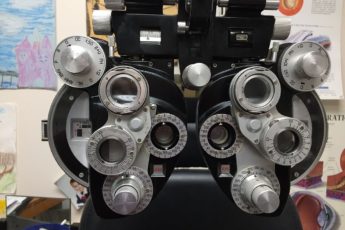
READING TIME: 3 MIN
Time had fleeted since we discovered that Gabriella had contracted cataracts, as I described last week. The extraction surgeries went well, general anesthesia and all. But now she couldn’t see anything more than a blur. Lisa had already called the New Jersey Commission for the Blind; they were lovely people, but not the first visitors we looked forward to hosting after surgery.
It wasn’t a hopeless situation. In a couple years, once her eyes stopped growing, the ophthalmologist could do two more surgeries to implant artificial intraocular lenses.
In the meantime, we had our choice of props – glasses or contact lenses. Thus began a comical back and forth.
There were different sizes of contact lenses, and we played it safe and ordered two. We tried the smaller ones first, and the ophthalmologist put them in himself. (The lenses required changing every week, and we saw that this routine would quickly get old, both for him and for us.) Whether due to itching or novelty, Gabriella spread her lids and pressed her fingertips to the surface. Just watching this made my own eyes water, but surgery had desensitized her nerve-endings.
At first, she was unable to disturb the lenses. Then after two weeks, she plucked one out. With a flashlight, we located the sparkle on her knit blouse and put it back in. This time it took only days before she flicked it out again.
Now we stood sentry, hovering at cribside or over the playpen, ready to pounce. Anything to prevent her sticking her fingers in her eyes. “Gabriella, no!” we’d cry.
That only made her enjoy it more.
It soon became impractical to depend on the doctor to put the lenses back in, so we developed our own insertion process. With her flailing her flaccid arms, I stretched her lids apart and Lisa dropped the lens in the gaping eye. One thing we’d already learned was that we could make anything work when we needed to.
In the midst of all this, Gabriella underwent her strabismus surgery to correct the crossing of her eyes. Soon after, we got eyeglasses, bottle-lenses that magnified her empty eyes. Speckled pink frames, amazingly, were the least obvious we could find.
We suspected how she’d react even before they set the glasses on her nose and ears for the first time, the curvy plastic ends wrapping around the underside of her lobes, and we were right. They became her favorite teething toy.
Everything went into her mouth by that point, and her glasses would always be at hand. I watched her snatch them off her face and marveled at her improving two-handed coordination.
Within weeks, we replaced the frames because the earpieces were rubbing raw patches under her lobes. The next pair was looser, and thus easier prey for the snatch-and-gnaw. First we smiled at her quick hands, then we were overcome with silliness.
Time passed, a blur as much for me looking back as daily life must have been for her. The Commission brought her a black box of toys that featured sound and texture. At some point, we went back to contacts. Whichever correction we were using at the time, family and friends helped us guard her eyes.
Then came two more procedures, different from all those before because we planned them months in advance and because they offered hope. We returned to that same hospital, the same ophthalmologist and the same anesthesiologist, but this time we occupied the larger waiting room upstairs. Thinking back to the day of her birth, I tried not to get complacent. When they implanted the intraocular lenses, one nine weeks after the other, we finally completed the cycle we had begun two years earlier.
The new lenses were as artificial as bottle-blonde hair, but unlike the cataracts, unlike the distorting glasses or the elusive contacts, there was something magical about them. She seemed happier, more responsive. They sparkled when the light caught them. And after the second insertion, both of her pupils looked perfect once more.








Leave a Comment